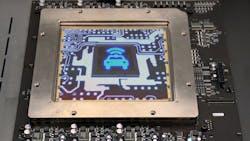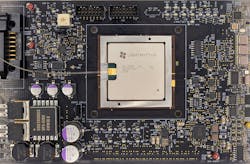Photonic Computing Delivers the Upleveling AVs Need to Reach the Fast Lane
What you'll learn:
- How photonic computing may provide the added AI compute power needed to uplevel autonomous vehicles.
- What’s holding AVs back from reaching full SAE level 5 driving capabilities?
- Reasons why achieving truly autonomous driving is extremely difficult from a technical perspective.
Today, a vehicle’s software functions are traditionally powered by dozens of electronic control units (ECUs) that are distributed throughout the car. Each ECU is specialized to operate one aspect of the vehicle. For example, one unit controls windows, one locks the doors, another controls power steering, and so on.
Finding ways to centralize and unify the control architecture in the car is an essential step toward enabling real-time data compute and the integration of advanced software features needed for truly automated and autonomous driving. This holy grail, SAE level 5, as defined by the National Highway Traffic Safety Administration (NHTSA), is when the vehicle can safely perform all functions under all conditions without driver interference. To accomplish this, an extreme amount of AI compute is needed.
Experts recently studied the potential of smart-connected homes and advanced automobiles, and they determined there to be 22 different sensors within a car that AI could empower and uplevel. Those experts said that due to the complexity associated with AI compute, and power demands of state-of-the-art microprocessors, current vehicle control and compute technologies would only realistically be able to handle around three AI chips at one time—not close to the 22 identified as required for a vehicle to operate truly autonomously.
While driving, humans subconsciously absorb and process multiple streams of data and constantly make decisions based on that information in real-time without even considering it. Examples of data absorbed and processed include changes in situations, inside and outside of the vehicle, relating to personal safety, passenger safety, and pedestrian safety. Then there are speed limits, road blocks, lane changes, traffic jams, construction zones, school zones, crosswalks, relative speed, speed limits, weather conditions, visibility, and more.
In reality, for a driverless vehicle to accomplish all of this as—or more—safely than a human, significant AI compute power with near zero latency will be needed to process the torrent of sensor data being generated real-time.
The Uphill Battle for AVs is Already Underway
In addition to the sensor integration and currently unavailable AI compute capacity, a huge obstacle to fully autonomous driving is the amount of heat generated by prevailing semiconductor chip architectures when processing heavy AI workloads. The hotter the chips get, the worse they perform.
In addition, while requiring significant battery power to operate, that excess heat also has to be dissipated, often using heatsinks and fans that then draw even more battery power. The resulting negative impact on a vehicle whose performance and range is largely determined by battery capacity becomes obvious.
Vehicles considered high automation, SAE level 4, can operate in self-driving mode, but usually with some restrictions. For example, Navya, a French self-driving solutions company, has already been selling level 4 shuttles and cabs in several parts of the world that can reach top speeds of 55 miles per hour. Alphabet’s Waymo is also operating a level 4 taxi service in parts of Arizona, and Cadillac recently unveiled its AV offering in a 2021 Super Bowl commercial.
So, manufacturers are making some progress, and real-world examples of level 4 driving are starting to make an appearance. Still, even the most advanced autonomous vehicles are challenged by the same problem: inefficient, power-hungry compute options that put a limit on vehicle utility and drivable range and give off far too much heat to be a sustainable AV option. Current chip architectures for compute are limiting the industry and holding it back from making the leap to full level 5 driving capabilities.
From AI-Driven Data Centers to Autobons, Photonic Computing Can Handle the Load
Enter photonic computing. We’re at the brink of proven photonic AI compute systems becoming commercially available at scale for data centers, and other vertical industries will naturally take notice. The AV automotive industry should be one of the first.
The AI photonic processor is a general-purpose AI inference accelerator that uses photons (laser light) instead of electrons to compute and transport data (see figure). As a result, photonic computers dramatically increase processor speed and substantially reduce heat generated. Simply put, photonic computing is about to change the way the world is approaching huge AI workloads.
Since 2010, the amount of compute power needed to train a state-of-the-art AI algorithm has grown at five times the rate of Moore’s Law scaling—doubling approximately every three-and-a-half months. Given the growing number of applications built on top of AI engines impacting our everyday lives, finding a solution to this performance scaling mismatch is a big reason why data-center operators are sitting up and taking note of photonic processors. Enabling faster compute at lower operating power overall is where photonics is king.
For these same reasons, photonic computing is likely the perfect solution to the AV need for AI processing of multiple sensor data, in real-time, with low latency at low power.
As already noted, the sheer number of real-time calculations needed for a driver to make sound, split-second (and often life-saving) decisions are numerous and daunting. Establishing a truly autonomous vehicle that checks the box as SAE level 5 is going to require a massive amount of AI compute that delivers superior processing speed and high energy efficiency. AI processors powered by photonic computing have the performance, low latency, and efficiency required to get vehicles from SAE level 4 to level 5.
Promises of all-electric, zero-emission car fleets in the not-too-distant future ultimately means even more power efficiency will be needed from every component of the vehicle. In-vehicle AI using photonic compute may be the critical technology that enables the automobile industry to deliver an economic SAE level 5 AV/EV product. The hope is that the autonomous car industry sees the benefits of photonic computing early enough to integrate it as part of a holistic solution, rather than a costly afterthought.
About the Author
Nick Harris
CEO and Co-founder, Lightmatter
Nick Harris is the CEO and co-founder of Lightmatter, where his team is leading the evolution of computing, reducing its impact on our planet, and enabling the next great leaps in human progress through silicon photonics. Prior to founding Lightmatter, Nick was an Intelligence Community Postdoctoral Fellow and National Science Foundation Fellow at MIT, where he received his PhD in Electrical Engineering and Computer Science.
Nick has authored 70 academic articles and 20 patents, and his doctoral thesis was titled “Programmable nanophotonics for quantum information processing and artificial intelligence.” Nick was previously an R&D engineer working on DRAM and NAND circuits and device physics at Micron Technologies.

